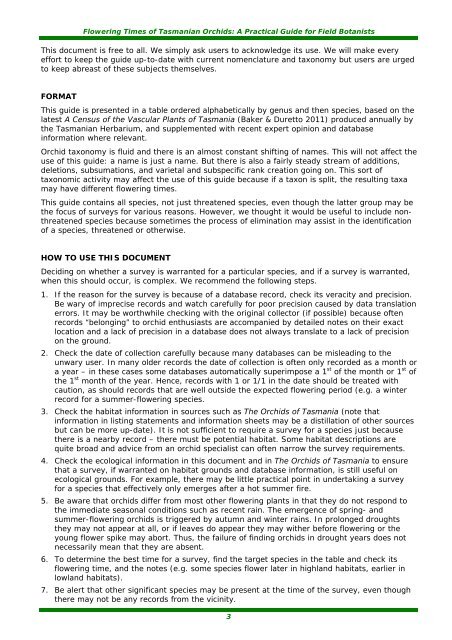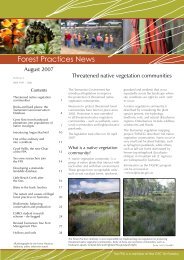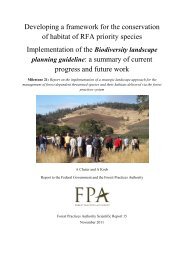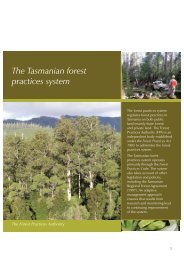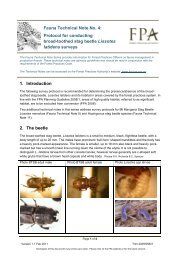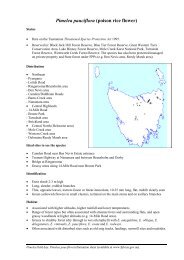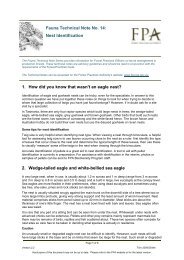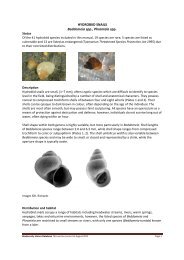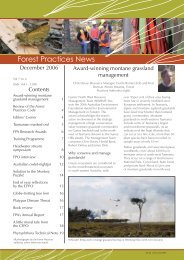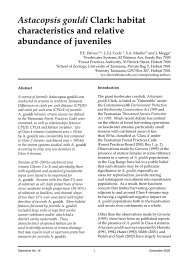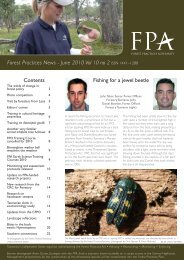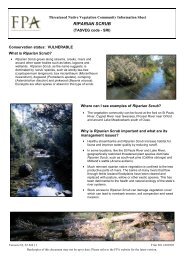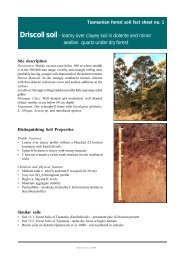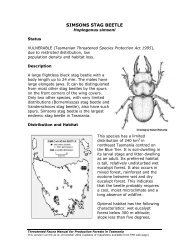Flowering Times of Tasmanian Orchids - The Forest Practices ...
Flowering Times of Tasmanian Orchids - The Forest Practices ...
Flowering Times of Tasmanian Orchids - The Forest Practices ...
You also want an ePaper? Increase the reach of your titles
YUMPU automatically turns print PDFs into web optimized ePapers that Google loves.
<strong>Flowering</strong> <strong>Times</strong> <strong>of</strong> <strong>Tasmanian</strong> <strong>Orchids</strong>: A Practical Guide for Field Botanists<br />
This document is free to all. We simply ask users to acknowledge its use. We will make every<br />
effort to keep the guide up-to-date with current nomenclature and taxonomy but users are urged<br />
to keep abreast <strong>of</strong> these subjects themselves.<br />
FORMAT<br />
This guide is presented in a table ordered alphabetically by genus and then species, based on the<br />
latest A Census <strong>of</strong> the Vascular Plants <strong>of</strong> Tasmania (Baker & Duretto 2011) produced annually by<br />
the <strong>Tasmanian</strong> Herbarium, and supplemented with recent expert opinion and database<br />
information where relevant.<br />
Orchid taxonomy is fluid and there is an almost constant shifting <strong>of</strong> names. This will not affect the<br />
use <strong>of</strong> this guide: a name is just a name. But there is also a fairly steady stream <strong>of</strong> additions,<br />
deletions, subsumations, and varietal and subspecific rank creation going on. This sort <strong>of</strong><br />
taxonomic activity may affect the use <strong>of</strong> this guide because if a taxon is split, the resulting taxa<br />
may have different flowering times.<br />
This guide contains all species, not just threatened species, even though the latter group may be<br />
the focus <strong>of</strong> surveys for various reasons. However, we thought it would be useful to include nonthreatened<br />
species because sometimes the process <strong>of</strong> elimination may assist in the identification<br />
<strong>of</strong> a species, threatened or otherwise.<br />
HOW TO USE THIS DOCUMENT<br />
Deciding on whether a survey is warranted for a particular species, and if a survey is warranted,<br />
when this should occur, is complex. We recommend the following steps.<br />
1. If the reason for the survey is because <strong>of</strong> a database record, check its veracity and precision.<br />
Be wary <strong>of</strong> imprecise records and watch carefully for poor precision caused by data translation<br />
errors. It may be worthwhile checking with the original collector (if possible) because <strong>of</strong>ten<br />
records “belonging” to orchid enthusiasts are accompanied by detailed notes on their exact<br />
location and a lack <strong>of</strong> precision in a database does not always translate to a lack <strong>of</strong> precision<br />
on the ground.<br />
2. Check the date <strong>of</strong> collection carefully because many databases can be misleading to the<br />
unwary user. In many older records the date <strong>of</strong> collection is <strong>of</strong>ten only recorded as a month or<br />
a year – in these cases some databases automatically superimpose a 1 st <strong>of</strong> the month or 1 st <strong>of</strong><br />
the 1 st month <strong>of</strong> the year. Hence, records with 1 or 1/1 in the date should be treated with<br />
caution, as should records that are well outside the expected flowering period (e.g. a winter<br />
record for a summer-flowering species.<br />
3. Check the habitat information in sources such as <strong>The</strong> <strong>Orchids</strong> <strong>of</strong> Tasmania (note that<br />
information in listing statements and information sheets may be a distillation <strong>of</strong> other sources<br />
but can be more up-date). It is not sufficient to require a survey for a species just because<br />
there is a nearby record – there must be potential habitat. Some habitat descriptions are<br />
quite broad and advice from an orchid specialist can <strong>of</strong>ten narrow the survey requirements.<br />
4. Check the ecological information in this document and in <strong>The</strong> <strong>Orchids</strong> <strong>of</strong> Tasmania to ensure<br />
that a survey, if warranted on habitat grounds and database information, is still useful on<br />
ecological grounds. For example, there may be little practical point in undertaking a survey<br />
for a species that effectively only emerges after a hot summer fire.<br />
5. Be aware that orchids differ from most other flowering plants in that they do not respond to<br />
the immediate seasonal conditions such as recent rain. <strong>The</strong> emergence <strong>of</strong> spring- and<br />
summer-flowering orchids is triggered by autumn and winter rains. In prolonged droughts<br />
they may not appear at all, or if leaves do appear they may wither before flowering or the<br />
young flower spike may abort. Thus, the failure <strong>of</strong> finding orchids in drought years does not<br />
necessarily mean that they are absent.<br />
6. To determine the best time for a survey, find the target species in the table and check its<br />
flowering time, and the notes (e.g. some species flower later in highland habitats, earlier in<br />
lowland habitats).<br />
7. Be alert that other significant species may be present at the time <strong>of</strong> the survey, even though<br />
there may not be any records from the vicinity.<br />
3


